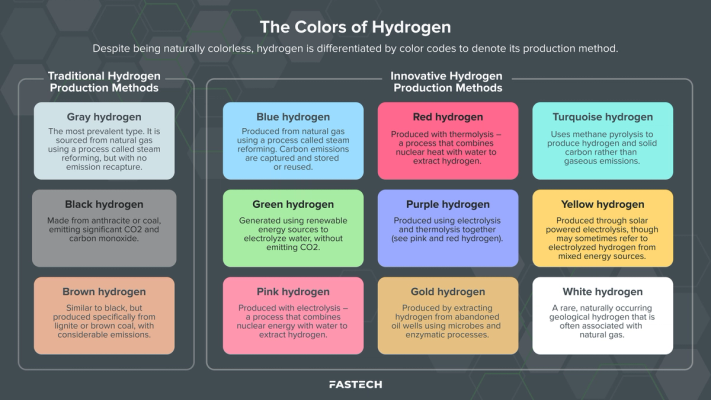The Colors of Hydrogen, Explained

The Colors of Hydrogen, Explained
Switching to sustainable forms of energy is critical to reducing the greenhouse gas (GHG) emissions that drive climate change. Hydrogen is an alternative fuel source that emits zero carbon during its use, only emitting heat and water vapor.
Hydrogen is functionally the same no matter where it’s sourced, but its method of production is a leading factor in its eco-friendliness. That is to say, not all hydrogen is created equal.
So, what exactly sets the different colors of hydrogen apart, and why should we care?
Read on to find out.
What Color is Hydrogen?
Hydrogen is naturally colorless.
In conversations about hydrogen production, the energy industry uses a color spectrum to differentiate types based on how it was sourced. This color system simplifies hydrogen's complexity, fostering a clearer understanding of its diversity in lifecycle emissions and applications.
The hydrogen spectrum currently spans 12 colors, but not all of them are currently accessible. Each color suggests unique production methods, use cases, and implications for the future of hydrogen energy.

Table of Contents
Traditional Hydrogen Production Methods:
- Gray hydrogen
- Black hydrogen
- Brown hydrogen
Innovative Hydrogen Production Methods:
- Blue hydrogen
- Green hydrogen
- Pink hydrogen
- Red hydrogen
- Purple hydrogen
- Gold hydrogen
- Turquoise hydrogen
- Yellow hydrogen
- White hydrogen
Innovative Hydrogen Production: Advancements and Trends
Traditional Hydrogen Production Methods
Historically, hydrogen has been produced using methods that emit high levels of greenhouse gases, which undermines its reputation as a clean fuel. These emission-heavy processes still dominate global hydrogen production. Understanding them is essential to grasp how the industry is shifting toward cleaner alternatives.
Gray Hydrogen
Gray hydrogen, the most common form of production today, is extracted from natural gas using a process called steam-methane reforming (SMR). This method releases significant greenhouse gases, including carbon monoxide (CO), which is typically not captured.
While carbon capture technologies exist, they require additional investment and are not widely adopted. As a result, nearly all hydrogen used in industry today is still produced using this high-emissions process.
Black Hydrogen
Black hydrogen, produced from anthracite or “black coal,” is a traditional hydrogen production method with notable environmental drawbacks. The process that converts coal into hydrogen (and other byproducts) is called gasification. Coal gasification emits substantial carbon dioxide (CO2) and carbon monoxide, both GHG emissions.
Black hydrogen, once sourced, burns as cleanly as any other variety. However, its environmental impact underpins the importance of color classification to differentiate how the hydrogen was produced.
Brown Hydrogen
Brown hydrogen, derived from lignite or “brown coal,” shares close similarities with black hydrogen. The gasification of brown coal also releases significant CO2 and CO into the atmosphere, though slightly less than black coal due to a lower carbon content.
Both production methods highlight the need to transition to cleaner hydrogen sources. Thankfully, there are already several options that mitigate or eliminate the pollution associated with traditional hydrogen production.
Innovative Hydrogen Production Methods
As hydrogen energy evolves, new production methods are emerging—each represented by a different color. These innovations mark a critical shift toward more sustainable, low-emission energy solutions.
Blue Hydrogen
Blue hydrogen is made through steam-methane reforming, similar to gray hydrogen. SMR mixes natural gas with hot steam and a catalyst to separate the hydrogen (H2) molecules from the methane (CH4).
The key difference is that blue hydrogen leverages carbon capture and storage (CCS) technology. The SMR process becomes carbon neutral once the harmful GHG emissions are removed from the equation. Captured carbon can even be used in fueling, energy production, and industrial processes.
Blue hydrogen is a significant improvement over traditional production methods but it still involves emissions over its lifecycle. Drilling, extraction, and transportation of natural gas uses equipment that typically runs on fossil fuels.
There’s also the potential for methane leakage during processing. Although methane has a shorter atmospheric lifetime than carbon dioxide, just one tonne has the same global warming potential (GWP) as 28-36 tonnes of carbon dioxide after 100 years in the atmosphere.
Green Hydrogen
Green hydrogen is a true zero-emissions energy source, often called the future of clean energy. Where other hydrogen colors emit greenhouse gases somewhere in their lifecycle, green hydrogen does not.
Green hydrogen is produced using electricity from renewable sources such as hydro, solar, or wind power.
This is achieved through a process known as electrolysis, where water molecules are split into hydrogen and oxygen with an electric current. The hydrogen is extracted as fuel, and the oxygen is then vented into the atmosphere with no negative environmental impact.
The result is a completely clean form of hydrogen made from renewable energy sources and zero carbon emissions.
Pink Hydrogen
Similar to green hydrogen, pink hydrogen is generated through electrolysis. But rather than powering the process with renewable energy sources like solar or wind power, pink hydrogen is produced through electrolysis powered by nuclear energy.
Integrating electrolysis into nuclear power generation is a cost- and production-efficient hydrogen solution. Nuclear power is also a natural source of intense heat that can be channeled to improve electrolysis efficiency or to make steam for SMR.
The drawbacks of pink hydrogen are the same as those for nuclear energy as a whole. Though safe and highly efficient energy sources, nuclear plants are expensive to build, operate, and maintain. Nuclear waste storage also poses unique challenges.
Red Hydrogen
Red hydrogen, a variant of pink hydrogen, is produced with thermolysis. The heat generated by nuclear power production is used as a catalyst for splitting water molecules. This process showcases the dual-purpose functionality of using nuclear energy to extract hydrogen efficiently.
Purple Hydrogen
Purple hydrogen is the most efficient form of nuclear-powered production, leveraging electrolysis and thermolysis together. Also referred to as thermochemical electrolysis, this cutting-edge method utilizes both the electrical and heat energy of nuclear power to facilitate maximum production volume
Gold Hydrogen
Gold hydrogen is extracted from abandoned oil wells or coal mines using microbes. This innovative approach was inspired by the natural processes in oceanic microbiology.
Several types of microbes can digest the organic materials left in these reservoirs and release hydrogen as a byproduct. Enzymes are used to speed the process along and maximize production, while a gas capture system collects the hydrogen released. This cost-effective and sustainable approach gives depleted oil fields revitalized purpose.
Despite regulatory challenges like carbon dioxide emissions during the microbial process, gold hydrogen is a significant leap towards efficient and environmentally friendly energy.
Turquoise Hydrogen
One of the newer forms of hydrogen production, turquoise hydrogen, uses methane pyrolysis to produce hydrogen and solid carbon rather than gaseous emissions. Solid carbon eliminates the need for more costly emission capture and storage equipment. In addition, the resulting carbon can be used in other applications, like manufacturing tires or improving soil.
Yellow Hydrogen
Yellow hydrogen is an emerging production method using solar-powered electrolysis. However, yellow hydrogen can also refer to hydrogen generated through electrolysis using mixed energy sources.
Among the hydrogen colors, yellow is tied with green as the most sustainable production method.
The synergy between solar and hydrogen power unlocks more opportunities for both. Using the Sun to power electrolysis provides hydrogen with zero lifecycle emissions. Hydrogen is also easier and more efficient to store than electricity, allowing it to serve as a battery for intermittent solar power.
Yellow hydrogen may even play a vital role in sustainable power grid stabilization.
White Hydrogen
White hydrogen refers to geological hydrogen found in naturally occurring underground deposits. With deposits already identified around the world and other theorized locations, white hydrogen could prove an ample power source. However, its deep position within the Earth’s crust puts it out of reach in most cases.
Though some energy producers have proposed plans for white hydrogen production, these projects are still in the early stages at the time of this post.
Innovative Hydrogen Production: Advancements and Trends
The hydrogen industry is witnessing a transformative shift with advancements and research driving innovation in production technologies. Recent studies showcase the potential of novel methods to produce hydrogen with reduced environmental impact.
From breakthroughs in electrolysis efficiency to the exploration of microbial processes, staying abreast of these developments is crucial for understanding the latest trends in the industry.
Read how FASTECH built a pioneering Tri-generation fueling facility in Long Beach, CA.
The Future of Hydrogen Energy
Overall, hydrogen is a critical component of global efforts to address the pressing challenge of climate change.
By transitioning from fossil fuels to hydrogen, we can significantly reduce our carbon footprint and slow the pace of climate change. In addition to reducing emissions, hydrogen will create jobs, improve energy security, and promote sustainable development.
However, there is one form of hydrogen that has the potential to be a game-changer in the transition to a low-carbon economy: green hydrogen. It can be used as a clean fuel for transportation, heating, and industrial processes and can help decarbonize difficult sectors to electrify.
The cost of producing green hydrogen is currently higher than other hydrogen colors. Still, experts predict this will change as technology improves and economies of scale are achieved.
Governments worldwide are investing heavily in green hydrogen infrastructure, research, and development, which is expected to drive down costs further.
With its versatility and potential to reduce greenhouse gas emissions, green hydrogen has a promising future as a vital component of a sustainable energy system.
Partner With FASTECH For Hydrogen Infrastructure Projects
Hydrogen stands as a crucial player in the ongoing transition to renewable energy. It offers industries a powerful means to significantly curtail carbon emissions while addressing climate change’s pressing challenges.
As a leading provider of hydrogen fueling infrastructure solutions, our track record at FASTECH speaks volumes. Having successfully built over 30 hydrogen stations for industry giants like Shell and Chevron, we bring unparalleled expertise to the table.
Our end-to-end Engineering, Procurement, and Construction (EPC) services cover everything from design and engineering to construction, maintenance, testing, and compliance.
Embrace the future of sustainable energy with FASTECH as your trusted partner. If you're gearing up for an upcoming energy infrastructure project, connect with us today and pave the way to a greener, more resilient tomorrow.





